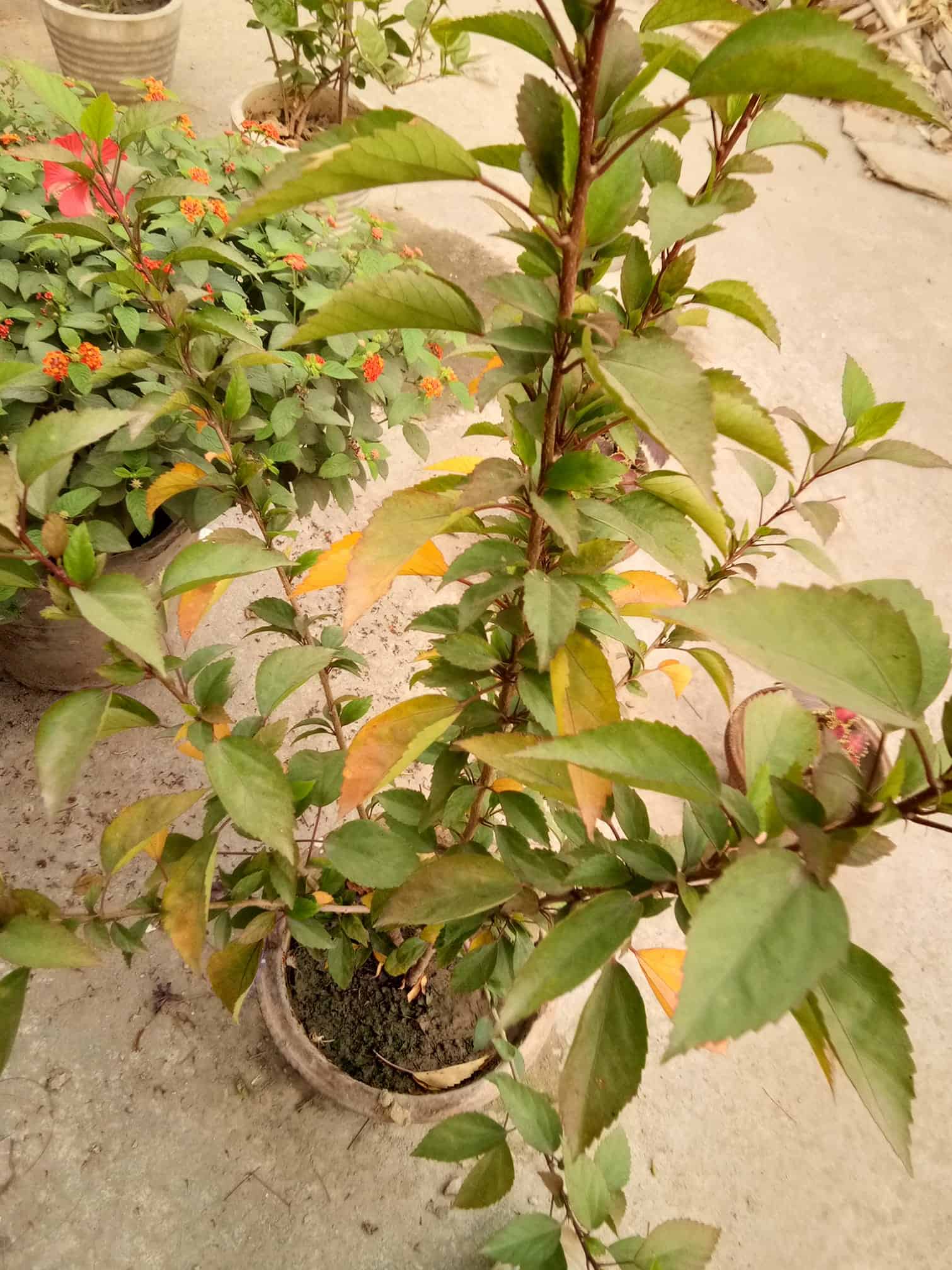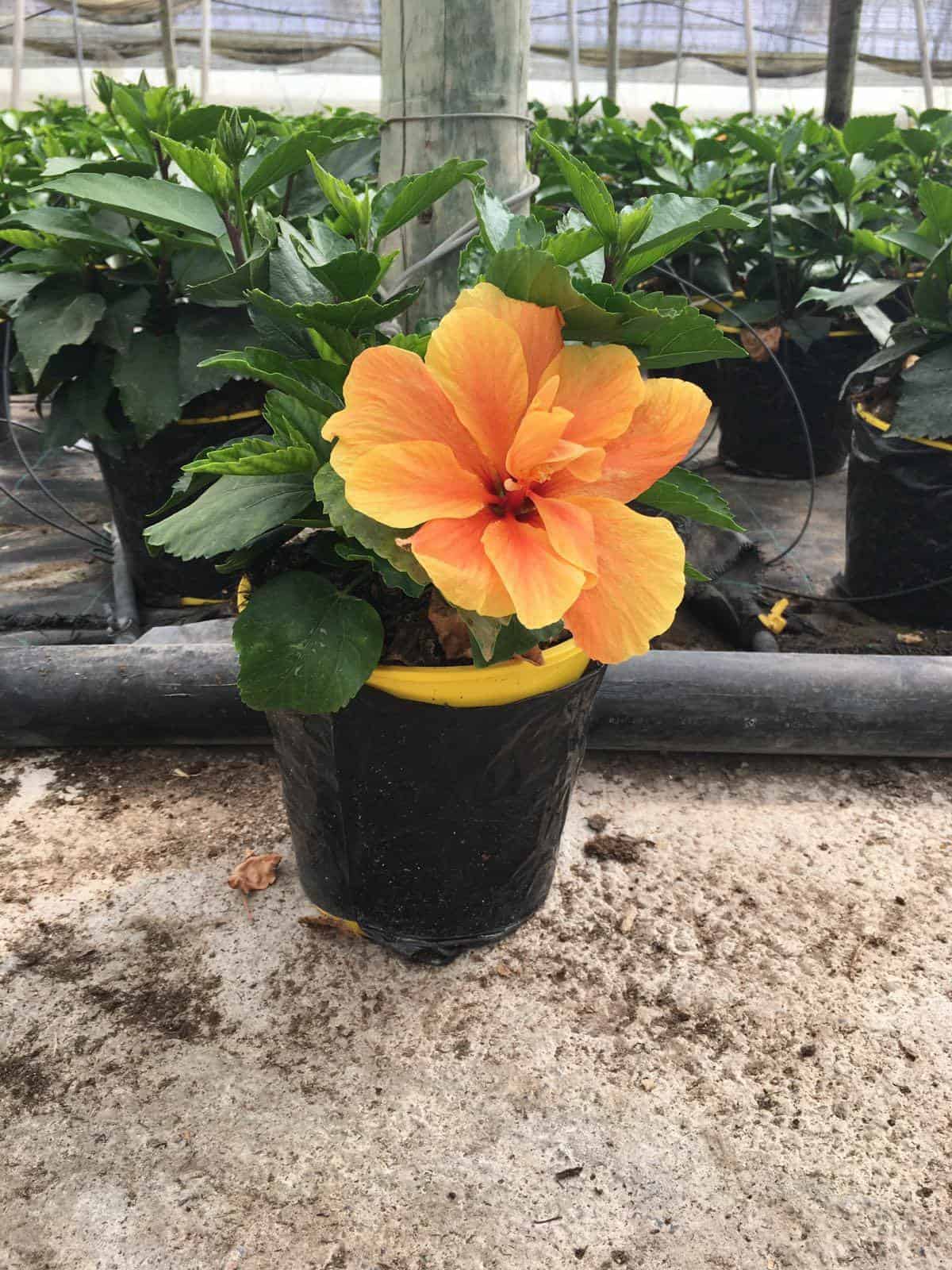The colorful Hibiscus flowers are delightful to look at, but the same cannot be said about the leaves, especially when Hibiscus leaves turn yellow and fall off.
Read more to find out what factors may induce yellowing in Hibiscus leaves and ways to quickly fix them.
Table of Contents Show
Why does my Hibiscus Leaves Turn Yellow and Fall off? (Reasons & Solutions)
Hibiscus is a flowering plant from the Malvaceae family that bloom every summer in shades of white, pink, red, burgundy, and lavender.
These flowers are sun lovers and are widely found in homes and gardens throughout zones 5-9 or sometimes up to zone 12 when grown outdoors.
Remember, Hibiscus varieties are picky about lighting, watering, and temperature; without those, the plant will fail to flourish.

You could tell this by the yellowing leaves in spring and summer that may turn brownish, sag, or even fall off as the condition progresses.
Therefore, you should never disregard the leaf appearance as it equally determines the success of flowering.
Here are some probable causes of yellowing and falling foliage, along with treatment for yellow leaves on Hibiscus.
1. Lack of Direct Sunlight
Hibiscus thrives in full sun (100,000 lux), not dappled light but direct sunlight.
Therefore, these tropical plants will suffer when deprived of ample lighting in the growing seasons.
Hibiscus growing in prolonged partial shade, such as indoors, is more likely to exhibit fewer flowers and yellowing leaves.
The light-deprived leaves will turn pale and discolored, showing pale yellow foliage due to a lack of chlorophyll.
On the other hand, too much direct sunlight can burn the leaf, inviting white spots to appear over the foliage.
Therefore, Hibiscuses are best grown in pots that can be moved under shade when required or in a garden that provides partial shade at the latter part of the day.
Immediate Solutions
- Move your potted plant to full sunlight, such as in the south-facing window or patio.
- Gradually introduce the potted plant to full sunlight over two weeks to avoid sun damage.
- Allow more light to garden plants by removing the overhanging tree branches or moving the plant to the southern spot.
- Using pruning shear, remove heavily discolored leaves as they are unrecoverable.
Preventive Measures
- Provide a mix of full sun and partial shade to ensure healthier-looking leaves.
- When growing Hibiscus outdoors, choose an ideal spot that receives at least 5 hours of sun each day.
- When growing in a pot, keep them in the south- or west-facing window.
- For zones 11 or above, move your plant to the shade during mid-summer to prevent the risk of sunburn.
- For zones 4-9, you can expose your plant to full sunlight even on summer days.
2. Inappropriate Watering
Hibiscus thrives in moist soil, especially during excessive heat or windy conditions, but it hates sitting in a pool of water.
Overwatering is the primary cause of root stress and decay problems, which often lead to yellowing leaves that starts around the bottom and proliferates upwards.

Nevertheless, denying the plant enough water will dry out the leaves, especially during spring and summer.
So, take an idea is to maintain consistent moisture in the soil to keep the roots healthy and prevent foliage from drying out.
Immediate Solutions
- Start trimming off affected leaves (excessive yellowing or curling) and dropping flower buds to redirect energy toward healthy growth.
- Proceed with thoroughly watering the dry plant and place it in a warm, sunny location.
- Immediately cut back on watering for soggy soil and let it naturally dry.
- Give it a week and check whether the plant flourishes; otherwise, proceed with diagnosing root decay.
Preventive Measures
- Provide Hibiscus with one inch of water 2-3 times a week in the summer when the soil dries out quickly.
- Weekly or bi-weekly watering would be enough during spring when the leaves and blossoms start to set.
- Water the plant only when the soil feels dry to touch in the fall and winter, usually 10-14 days.
- Use a soil moisture meter or finger to check whether the top 1-2 inches of soil feel dry before watering.
3. Temperature Stress
Temperature stress is a severe concern for Hibiscus leaves as heat stress will suck them dry, and too cold will send them into stress.
The plant needs lots of water in the hot summer to maintain its appearance, but the soaring temperature will dry out the soil and leaves.
Anything over 85°F can dry out the leaves, leading to yellowing tips and a curly appearance.
On the other hand, freezing temperatures or anything under 50°F will stress the plant, leading to pale yellow and falling leaves.
It is especially true with garden-grown Hibiscus or potted ones in the open window.
Immediate Solutions
- Start with trimming excessively droopy or curled, yellowed leaves.
- Bring the potted plants inside the home into a bright room to provide shade and warmth.
- Watering the outdoor plants frequently throughout the week to boost moisture and humidity in the air.
- Otherwise, wrap outdoor Christmas lights around the plant and cover it with a freeze cloth to increase temperature.
- Applying the growth enhancer to cold-damaged plants can work wonders to prevent stress, but be mindful of the application ratio and frequency.
Preventive Measures
- Provide an ideal temperature between 65°F to 75°F during spring and summer.
- Cut back on fertilizing when the temperature drops below 50 degrees Fahrenheit.
- Potting Hibiscus with an ideal potting mix is always better, so you can move it inside.
4. Lack of Nourishment
Being a tropical flowering plant, Hibiscus is picky about regular nourishments, including Phosphorus boost.
If your Hibiscus leaves turn yellow but are not falling off, it may indicate that the plant is experiencing iron chlorosis.
You can tell this by seeing the youngest leaves of Hibiscus that start turning yellow but still maintain green veins.
However, be wary about providing phosphorus-rich food, as Hibiscus does not tolerate the nutrients in high doses.
It may stunt new growth and invite droopy leaf appearance.
Immediate Solutions
- You can apply supplemental iron mixed with water by spraying directly onto the leaves.
- Alternatively, pour the iron solution into the soil by making a tiny hole, covering it, and watering afterward.
- Avoid using bloom booster to treat leaf yellowing as it lacks micronutrients essential for healthy leaf growth.
- Similarly, spray supplemental magnesium or Epsom salt mixed with water on the leaves if it misses the glossy green appearance.
Preventive Measures
- Fertilize your Hibiscus every two weeks in spring and summer using the formulated fertilizer with NPK 12-4-8 or 7-1-12.
- When using bloom booster, apply only once a month in the growing season.
- Do not unnecessarily apply iron or magnesium supplements, which can lead to mineral toxicity.
- Amend the potting soil with organic matter such as compost or manure when repotting to boost iron contents.
- Cut back on fertilizing in the fall and winter to help induce dormancy.
5. Pest Problem
Although rare, Hibiscus leaves turn yellow under severe pest infestation.
Keep an eye out for pests like spider mites, aphids, and mealybugs that suck sap off the leaves, turning your Hibiscus yellow.
Garden-grown Hibiscuses are more likely to encounter pests than indoor plants; hence, pay extra attention to outdoor counterparts.
You would mostly witness yellowing with tiny white speckles, brown bumps, a white fluffy substance on the undersides, and patches of sticky fluid on the infected leaves.
Other tell-tale signs include a mottled appearance and falling leaves.
Immediate Solutions
- Start with trimming infected leaves and flowers using a sterilized pruning shear.
- Wash the plant with a mild soapy water solution or use neem oil to kill the pests effectively.
- Alternatively, you can rub the insecticidal soap over the leaves and stems.
Preventive Measures
- Avoid overwatering and soggy soil conditions in the growing season.
- Cut away bushes, weeds, and grasses around the Hibiscus plant to eliminate the pest breeding ground.
- Avoid growing other plants close to Hibiscus bushes to reduce the likelihood of infection.
- Spray the plant with a mild soapy water solution or horticultural oil 2-3 times a year.
6. Insufficient Dormant Period
Like most perennial flowering plants, Hibiscus goes into dormancy in fall and winter to prepare for the upcoming spring.
The Hibiscus leaves turn yellow naturally and begin falling, indicating the rest period. So, you are likely to find yellowing and falling leaves.
However, do not make the mistake of providing additional water and plant food, as it counteracts dormancy.

Tips to Assist Plant with Dormancy
- Move your potted plant indoors in a low-light, warm area.
- Reduce watering and cut back on fertilization.
- Provide only a few hours of direct sunlight to keep the plant happy.
- Alternatively, place them under LED grow light for 4-6 hours if the sunlight is scarce.
- Consider covering the outdoor plants with transparent plastic or wrap if your region witnesses snowfall and freezing temperatures.
White Hibiscus best grows in zone 5-8 so grab the complete care guide to maintain the healthy plant!
From Editorial Team
Conclusion!
Hibiscus makes a beautiful flowering plant that blooms once a year and displays glossy green leaves.
Care to water regularly in the growing season, feed nutritional plant food, and provide ample direct sunlight and organic potting mix to ensure healthy-looking leaves preventing Hibiscus leaves turning yellow.
In most cases, the yellowing is a byproduct of lack of sunlight, which you can quickly solve by adjusting its location.


